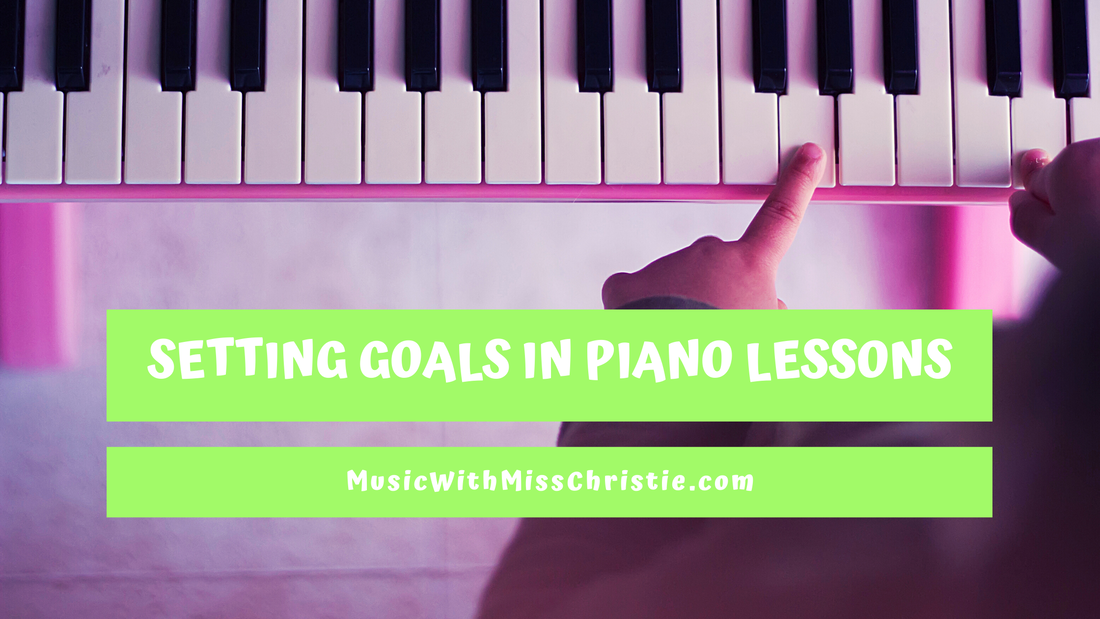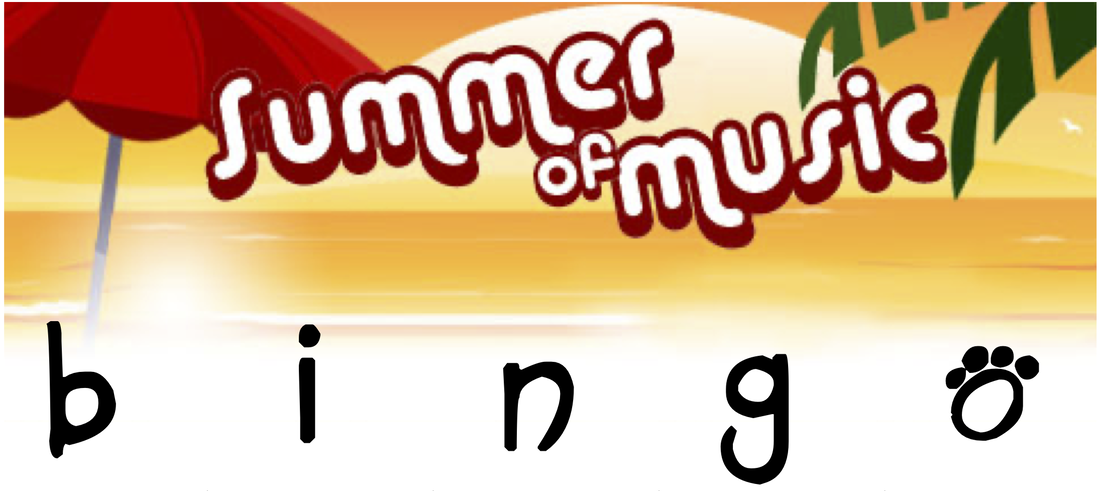|
Like many other piano teachers, I use the beginning of the school year to set goals for my students. I do a mid-year checkup in January and then set a separate goal for the summer. I call my student's goals their "Mission Statement" and they are responsible for helping create it each year. The Goal Setting Process I highly recommend that you get your students involved in setting their goals for the year. The importance of having students choose their own goals cannot be over stated. When children are able to have a say their own learning, they feel empowered and take more responsibility in their studies. But choosing goals can be really hard for a kid, because you don't know what you don't know. I've come up with some questions to help my students set their Mission Statement for the year. Questions for Young Beginner Piano Students For young piano students (5 & under) I ask them these three questions:
Most of them don't give me a completely coherent answer - okay, let's be honest, the little ones ramble - so I listen and then rephrase their response to fit into a two to three sentence Mission Statement. Questions for Elementary to Advanced Piano Students For older students, we get a little more involved. They choose one "what" question and one "how" question from the following list.
Students choose one "what" question and one "how" question from each list to answer and together we create their Mission Statement. I have them start their Mission Statement with "I (name)" then answer their two questions. After they've written it down, we take it over to the Mission Statement board in the waiting room. Putting it on the board makes official and keeps them accountable. I've found it really helps my students stay on task throughout the year. I've created this printable to help you and your students set their goals for the year. Do your students set their own goals? When do you set your student goals? Do you use a different method of setting those goals? I've love to hear your thoughts!
0 Comments
We may still be in quarantine, but I'm thinking ahead to summer when, hopefully, we'll be able to see our friends and family and students face-to-face. It's at that time when I'll be kicking the practice incentives into high gear. When I started teaching, I didn't have any trouble getting my students to practice over the summer. I'd give them an assignment, write a little practice log in their books, and they'd come back the next week with their work complete. Then about 7 years ago, something changed and I started hearing excuses..."I didn't have time", "I was at camp all day", "We went away for the weekend"...instead of music. So, over the past few summers, I've given my students fun and new ways to practice. One of those activities is Summer of Music Bingo. I haven't done this particular program in a few years and I'm excited to be bringing it back! How to Play: To complete the challenge, students must get bingo - 5 in a row (vertical, horizontal, or diagonal). And of course I will add an optional challenge to finish the whole board by the end of summer! Students color in the square when they've completed the activity and we go over the board together at every lesson to track their progress and answer questions. Once they achieve BINGO they are to take a picture of themselves with their BINGO board and send it to me! The Reward: It's up to you whether or not you want to give out prizes. Sometimes just letting the fun of finishing be the reward is just what kids need. In years past, the student(s) with the most activities completed at the end of August would receive a surprise at their summer piano party (more on that later). Since I'm not sure whether or not we'll be able to have our summer performance parties, I'm doing rewards a little differently. This year, I'm doing a 3 part reward system.
Most of the activities can be completed within a day or two, but some of the activities will take them a few days or weeks to complete. My goal for this, as it is with all of my practice incentives, is to encourage consistency in my students practice habits. Want your own copy of Summer of Music Bingo? Download the pdf here I love working with beginner students, especially little ones. Their creativity, imagination, and willingness to explore inspires & invigorates me. I particularly love the moments when they discover or master something new. The light in their eyes is beyond compare.
We as music educators know that those 30-minutes each we week spend with our students is crucial, but not enough to sustain growth in our students. Effective at home practice is essential to the development of every musician. Practicing can be a little mysterious, especially for young beginners. And if mom and dad don't have much musical experience they might be unable to help, which can make it feel confusing or overwhelming. Over the years I've come up with a variety of tools I use to help my students become independent learners, but practice steps have by far been the most helpful. Breaking down the practice process into easy, bite-sized pieces makes practice more manageable and helps beginner students develop successful practice habits from the start. The cool thing about these practice steps is that your beginner students will experience success with their new pieces before playing a single note. Two quick notes about counting and repetition of steps. Counting is essential through all of these steps! To count during every step, I have students say the finger number/letter name of the note then count the beats the note is held. For example, a whole note played on C would be said "C-2-3-4". I encourage my students to repeat each practice step at home only moving on to the next when they know they've mastered the previous enough to (almost) guarantee success. If they struggle too much with a step, I have them go back to the previous one and review it before trying again. Okay, now onto the Practice Steps! 1. Point & Read I've found this step to be the most crucial step for student success. This is the most basic form of music reading broken down to letter names (or finger number depending on their level) and hands. I have my students point to the notes with the matching hand and read the letter name out loud. There are a few things that I think lead to student success with this step. First, they're isolating the notes that they'll be playing without having to think about finger shape, fingering, rhythm, steady beat, dynamics, or any of the other technical necessities of playing the piano. Second, they are able to analyze their mistakes more quickly. Since their finger is right on the note on the page we both can see what they're looking at, I know whether or not they're looking in the right spot, and we can easily compare the current note to the ones around it making correction a breeze. Third, they're learning how to track the music on the page. How many times have you said, "Look at your music" or "Keep your eyes on the page" or "Stop looking at your fingers"? By bringing both the hands and the eyes onto the music itself, you're starting the connection between all working parts before they even play a note. And lastly, they're making associations between the notes and the hand (fingers will come later). I insist that my students point to right hand notes with their right hand and left hand notes with their left hand. This physical reminder translates seamlessly to their playing. 2. Tap & Read Tap and read is everything from Point & Read with one change, they're tapping the rhythm instead of pointing to the note. This step brings the rhythm to life without overwhelming your student with keys, fingers, technique, dynamics, etc. They're still saying the letter names and counting the rhythms AND they get to feel what those rhythms by tapping. This is where I start getting creative in my teaching. I've had students tap on drums, on tambourines, with rhythm sticks, on their shoes, their head, their bellies. Heck, I've even had students stomp the rhythm in her bare feet. All I ask is that they say the letter name, count the rhythm, and tap with the correct hand. Beyond that, anything goes with this step! I usually have my students do this and the first step a few times during their lesson and I'll sing the note names to help their ear hear what they'll be playing! 3. Play & Say (HS/HT as needed) Now they're ready to start playing! By this point, my student has read the note names, identified, tapped and counted the rhythms, and heard the piece through my voice. Even the most timid or perfectionistic learner will have enough experience to be able to play the new piece. When students play & say, they are saying the note names the same way they did in steps 1 and 2 and playing. It's completely okay if this step doesn't happen during the lesson. Setting up the student's base knowledge of what they're playing will enable them to achieve this step in their at home practice. 4. Play This final practice step is one that my students look forward to because I tell them they aren't allowed to do this step until they have masters steps 1-3! Once the first 3 steps are mastered, playing their piece will be so easy, they won't have to worry. They'll know when they're right and when they've made a mistake. They'll also know how to fix their mistake and learn from it! Here are two free resources to help get you started using practice steps with your students. Practice Step Post-Its are easily moved from piece to piece Practice Step Stickers are smaller Try using these practice steps with some of your beginning students and let me know how it goes! Looking for more resources? I'm adding more to my Teachers Pay Teachers Store all the time! |
Archives
February 2022
Categories
All
|


 RSS Feed
RSS Feed